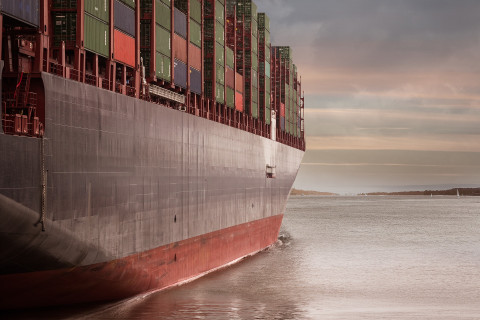Achieving a faster, cleaner and leaner port.
Read more about the project here.

Achieving a faster, cleaner and leaner port.
Read more about the project here.
Using sensors helps increasing the sustainability of the port area: “The port wants to be faster, cleaner and leaner and sensors contribute to this goal. The management and maintenance of these asses take less time. Mainly because we don’t have to visit the location to see if everything is going well. The data gives us the information we need. Moreover, this technique improves business, since ships make better use of the site so the chance of distortion decreases further”. --Joost Zuidema, project leader Sensors New Business at the Port of Amsterdam
Wireless sensors have been installed on top of industrial scale mooring posts (IJ-palen) in the Port of Amsterdam. 30MHz, an Amsterdam-based industrial IoT company, provides the technology to measure the impact of mooring bulk carriers and monitor the condition of the piles in real-time, 24/7. The Port of Amsterdam’s aim is to further improve the management of their assets. 30MHz foresees a strong increase in the use of wireless sensors in port areas.
In the Dutch port city of IJmuiden, on the North Sea, bulk carriers that lie too deep to get through the locks, transfer their load onto smaller vessels. During the unshipping process, the bulk carriers are attached to two very large mooring posts, known in Dutch as the IJ-palen. Recently mounted sensors record all movements, which are visualized real-time in a 3D graph. The department of management and maintenance of the Port of Amsterdam receives immediate notifications in the case of unusual movement.
In the preparatory phase of the project, 30MHz worked with the innovation experts at the Port of Amsterdam to overcome various challenges with. For example, the mooring posts are positioned in open and often raw water and aren’t equipped with any kind of AC or internet access. To resolve this, 30MHz applied a wireless form of communication in combination with a rechargeable power supply that lasts for a year.
It was also a challenge to ensure optimal availability of the information gathered by the sensors. 30MHz placed a gateway on top of the port’s control center in IJmuiden that communicates with the sensors across the sea canal. Next to that, special antennas were installed on two buoys close to the location and the IJ-palen themselves resulting in an optimal signal, even when a bulk carrier is moored in the line of sight. To deal with the harsh nautic conditions (wind, salt, gull droppings, dust and sun), reliable industrial materials were used for the casing of the sensors.
The sensors measure the extent to which a rubber bumper that is fixed to the posts is pressed in and to what extent the vessel is pushing the poles sideways or backward. These actionable insights are then personally translated into decisions whether to adjust, repair or replace parts of the IJ-palen. The latter is very important because of long delivery times.
Jurg van Vliet, CEO of 30MHz, foresees plenty of opportunities for the rapidly developing sensor technology, both inside and outside the maritime sector: “Sensors are also useful in the realization of so-called quay monitoring. Using this technology, barges know if a berth is available and are able to book it well before they reach the port. Sensor technology enables companies to interpret data from the physical world in an efficient and sustainable way. The information it gives you lets you improve business operations.”
Port of Amsterdam, 30MHz
The Port of Amsterdam and 30MHz are partners in innovation, continuously exploring new possibilities for industrial IoT.
Sensory data can serve as a tool to improve efficiency, enable predictive maintenance and drive sustainable productivity across sectors. Beyond maritime, 30MHz technology is used in industries including agriculture, smart city, commercial insurance and space utilization.
Get notified about new updates, opportunities or events that match your interests.

During this evening Paul Stefaan Mooij will introduce the DIY Smart Glasses he developed, he is bringing several 'arms'. The PMSG kit lets you swap out those boring old arms from your (sun)glasses for a custom-made PCBA that looks and functions like something a hacker MacGyver would dream up. It fits just like the original—using the same hinges, screws, and probably duct tape somewhere—but now you’ve got space for sensors, connectors, and all the IoT magic you can pack onto your temples.
Join us to experiment, learn and envision new sensors and possibilities.
https://www.hackster.io/psmooij/pmsg-prototype-modular-smart-glasses-8bd4e6
https://github.com/Control-C/PMSG
You don't have to rsvp via meetup, the workshop is from 19-21h in the Makerspace of the OBA and you can just walk in!
OBA: Oosterdokskade 143, 1011DL Amsterdam

Join us to learn to understand the concept of Meshtastic, an open source, off grid, decentralized, mesh network build to run on affordable low-power devices!
Prepare and configure your own device as to contribute to Amsterdam wide coverage, or just for fun / to chat:-)
The workshop is based on this device: https://nl.aliexpress.com/item/1005007752194012.html Of course you may bring a different device, it only might take a little extra effort on your part if the settings are different. We will try to help of course!
You don't have to rsvp via meetup, the workshop is from 19-21h in the Makerspace of the OBA and you can just walk in!
OBA: Oosterdokskade 143, 1011DL Amsterdam

For our end-of-the year event we have some extra opportunities to build, create and even program your own souvenir to take home!
Please if you want to make and take home the Xmas lights you see in the picture, the kit costs 25,- (we also have 2 Pay-It-Forward kits). Of course you can also work in other small projects or 3D print a small Xmas tree or make (for children!) a self designed wooden lamps!
You don't have to rsvp via meetup, the workshop is from 19-21h in the Makerspace of the OBA and you can just walk in!
OBA: Oosterdokskade 143 1011DL Amsterdam

